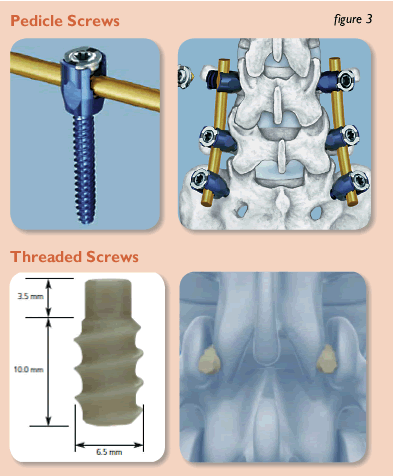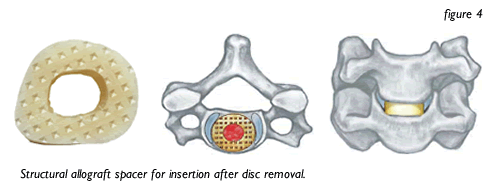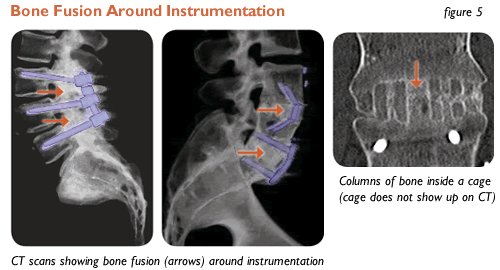|
Spinal Fusion—Science and Technology to the Rescue!Phillip Porter, MD The words “spinal fusion” bring fear to many patients, but much of this is related to misconceptions about these operations. Spinal fusion refers to a surgical procedure which mechanically or biologically stops movement between parts of the spine which normally should move. Mechanically doing so refers to using instrumentation (rods, screws, plates, cages etc.) to attach two mobile parts of the spine together (Figure 1). Such devices immediately stop movement of the spine but they can “fatigue” over time, resulting in failure due to breakage, loosening or pull-out. Biological fusion means having the body create bone which bridges the gap across the moving parts. This is achieved using the patient’s own bone (autograft), donated bone (allograft) or various substances which promote the formation of bone by providing support for bone in-growth or influencing cells to create new bone. Many operations involve combinations of mechanical and biological techniques using components that give immediate stability, but also result in bone formation over time.
Although sometimes overused as a treatment in the past, there are still many patients who require and benefit from a spinal fusion. Fusion is usually performed to treat or prevent spinal instability. In some situations related to degeneration (aging, arthritis), tumor or injury (falls, car accidents, etc.) – the spine has excessive movement at one or more segments. One of the key functions of the bones of the spine is to protect these structures. Excessive movement can result in severe pain or injury to the nerves or spinal cord. At other times the bone that needs to be removed during an operation to relieve pressure on the nervous system will result in future instability of the spine and therefore a fusion is done on a preventative basis. Although fusion can be a major operation, with newer devices and techniques there are cases in which the fusion portion of the operation adds fairly little time or risk to the surgery overall, with the decompression (taking pressure off the nerves) being the more challenging part. Spinal fusion is not an appropriate treatment for many of the most common causes of neck or back pain. In general these problems are brief and either self-limited or successfully treated non-surgically. Fusion operations are most commonly performed in the neck (cervical spine) and lower back (lumbar spine). They may be performed by gaining access to the spine from the front (anterior) or back (posterior) of the body. Figure 1 shows some of the devices commonly used to fuse the spine. Devices such as rods and screws are being made smaller or being replaced by versions which sit closer to (or even within) the
In the past typically bone was taken from the patient’s own body and used for fusion. While it is still common to keep any bone removed during spinal decompression to help with biological fusion, this can often be supplemented by donated (cadaver) bone or other biological substances rather than making a separate incision to get more bone from the patient. Donated bone may be made in a specific shape (structural) (Figure 4) or added in small pieces (morsellized) around instrumentation. One common substance used to enhance fusion, bone morphogenetic protein (BMP), has been the subject of much controversy in the media recently due to concerns about cost, side-effects and excessive use. Currently the scientific data suggests that use of this substance does increase the success of bone fusion, but caution needs to be exercised with use (especially in the neck) due to possible swelling. There are many other strategies for enhancing bone fusion which are under investigation.
The spine is subject to tremendous physical loads and repetitive motion. As a result, one concern with spinal instrumentation is that eventually any such device may fail by breaking or loosening. This is the key reason that achieving bone fusion is so important. Figure 5 shows some examples of CT scans in which the bone has solidly fused around the instrumentation. The most important thing that an individual can do to improve his or her chance of successful fusion is to stop smoking. Being compliant with the recommended activity restrictions and short-term use of a brace in many cases are also important. Generally once the bone has fused the instrumentation is simply left in place, although the function it serves at that point is minimal. With modern instrumentation it is still safe to have post-operative MRIs and the metal used will not set off airport security alarms.
In conclusion, don’t consider “fusion” a bad word. With advances in technology spinal fusion is often now performed with little added risk or discomfort and may be an important part of a successful outcome.
|
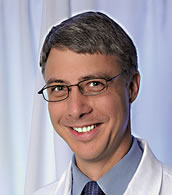


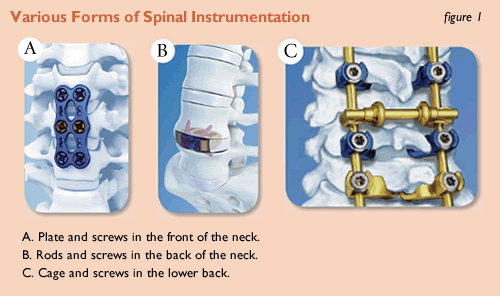
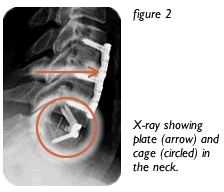 spine to increase ease of placement and reduce post-operative pain. For example, for the front of the neck there are options of a plate secured to the surface of the spine by screws or a cage-like device with screws which is recessed into the spine (Figure 2). Newer devices which represent a hybrid between mechanical and biological fusion give a degree of immediate stability plus lead to bone fusion. One such device is a threaded bone dowel which is precisely machined from cadaver bone in the shape of a screw. It screws into the joint which it is meant to fuse, resulting in immediate stability as well as long-term fusion of the patient’s own bone to it. It measures only about a half inch in length and is placed within the spine yet can sometimes be used instead of rods and pedicle screws which are several inches long and sit on the surface of the spine (Figure 3).
spine to increase ease of placement and reduce post-operative pain. For example, for the front of the neck there are options of a plate secured to the surface of the spine by screws or a cage-like device with screws which is recessed into the spine (Figure 2). Newer devices which represent a hybrid between mechanical and biological fusion give a degree of immediate stability plus lead to bone fusion. One such device is a threaded bone dowel which is precisely machined from cadaver bone in the shape of a screw. It screws into the joint which it is meant to fuse, resulting in immediate stability as well as long-term fusion of the patient’s own bone to it. It measures only about a half inch in length and is placed within the spine yet can sometimes be used instead of rods and pedicle screws which are several inches long and sit on the surface of the spine (Figure 3). 